This web page contains the logs of S/Y Thetis’ the fourth leg to the Black Sea. The 8 day leg covers our return voyage from the Black Sea with the S/Y Thetis. We left Samsun and sailed much more slowly than our outgoing leg back to Istanbul, hugging the coast and with frequent stops along the way. We stopped at Yakakent, Hamsilos Cove, Inebolu, Cide, Amasra, Eregli, Kefken Adasi, Poyraz, Tarabya, and Bebek. The logs are illustrated with maps and photographs, and also include some historical and geographical descriptions of the places visited as well as several links to other related web sites.
Note: A portion of his passage is also described by my brother Nikos Riginos in his Faneromeni website. Nikos had traveled in the Black Sea in the summer of 1998.
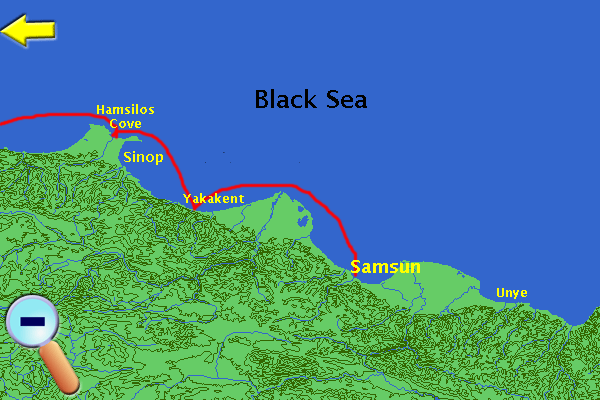
Thursday August 5, 1999, Day 24
Today is my daughter Corinna’s birthday. We were woken up by the alarm and started preparing for our departure from Samsun heading for Yakakent. We were not sorry to leave this dirty port which would have been unbearable had it not been for the warm hospitality of its people and of Ergin Bey in particular. We secured everything and by 0605 we were casting off Ergin’s mooring, towing the zodiac behind us. Normally, I avoid towing, but I did not want to raise the zodiac in this filthy water and dirty the deck. As expected the knotmeter did not work. This happens if you leave its impeller sensor in the water while the boat is not moving because it quickly gets clogged with small barnacles and weeds. Again I shied away from removing it because of the dirty water.
Outside the Samsun harbor, the wind was from NNE 18-25 knots. The waves were large, Andonis estimated them to be 5-7 m high. As soon as we were in relatively clean waters we stopped, raised the zodiac, and lashed it securely on the deck. Then we removed the knotmeter impeller, cleaned it, and reinstalled it. Now it worked. Once again we were on our way. It started to rain rather strongly. The ride against the large waves was very uncomfortable for a while. Fortunately the wind veered, which allowed us to open part of the genoa and motor-sail. This was both faster and more comfortable. We were averaging about 4 knots. This did not last for too long; the wind backed again to the W and forced us to roll-in the headsail. Thus we motored until we rounded Bafra Burnu when we changed course to 250°. Now the wind dropped to 6-12 knots WNW and once again we were able to motor-sail on a port tack. The ride now was definitely more comfortable. Some 10 M away from the harbor, a large school of dolphins approached us and stayed with us for over 40 minutes, frolicking right next to the boat, often jumping in pairs or in groups of 8 high out of the water, or crisscrossing our path right under Thetis. I do not recall another time that dolphins had stayed next to Thetis for so long. There were at least 20 individual in the group.
I tried to call Corinna and wish her a Happy Birthday but she was out so I left her a voice message. I then called Alice in Washington. She was getting ready to fly to Providence and visit Corinna.
We arrived in Yakakent [41° 38.4' N, 035° 30.4' E] at 1815, having come 55.5 M from Samsun. The harbor is large and not very deep. It consists of an inner and an outer harbor. The inner harbor was full of fishing boats which were rafted along the quay under strong lights. Figuring that it would not be very comfortable to be near the lights or the fishing boats, we first anchored within the inner harbor at 3 m depth. But people from ashore were waving to us to come side-to. We were not sure if this was because we might impede other boats entering or exiting the harbor or because they were curious about us. Just in case we were in the way, we raised the anchor and moved to the outer harbor. It was very calm but there were large jelly fish everywhere. As we were moving slowly and about to anchor and while our depth sounder indicated a comfortable depth of 3.8 m, we touched the bottom. Fortunately it was soft mud and we were moving slowly, so I was able to reverse and extricate ourselves. We anchored at 3.1 m (real this time). Very good holding.
I looked at the depth sounder. It was mysteriously set with a +0.5 m offset instead of a -0.5 m offset. I still have no idea what caused this. I corrected the offset and now we should be safe but we should be watching the instrument.
After an ouzo, I started cooking dinner. Our plan was to make a risotto con funghi using the wild mushrooms we purchased yesterday on the road to Amasya. While sautéing the mushrooms, I noticed an unpleasant odor. We tasted them. They had a most unappetizing bitter taste. Cooking time did not improve them and we had to throw them away. Quickly the plans for the risotto were changed, and we had to settle for a pilaf with tuna fish, capers, and onions. Tired, we went to bed. It was a very calm night and I fell into a deep sleep.
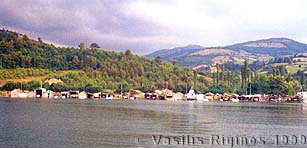
|
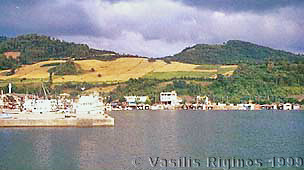
|
Friday August 6, 1999, Day 25
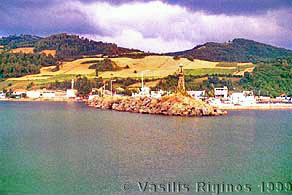
I was brutally woken up by a loud thud from the stern. I jumped out of by berth, grabbed a flashlight, and in a state of undress ran to the cockpit. I turned on the flashlight and shone in at the stern. There was a small row boat with a young man who was in the processes of tying his painter on Thetis. He asked where we came from. Without thinking I replied, from the US. He indicated that he wanted to come aboard and visit us. “Arkadas” (friend) he said. It was 1:00 AM! I tried, with sign language, to indicate to him that I wanted to go to sleep, “yarim” (tomorrow) I said, and pointed to my watch. Nothing going. He started climbing up the ladder. I said firmly, “No, hayir! Yarim arkadas!” Nothing going. I untied his painter while calling Andonis to help. Andonis was fast asleep. We were at a stand still. He had climbed back down to his boat and started re-tying his painter, I was calling to Andonis that we were being boarded by a pirate, while trying to fend him off. Finally, with all the commotion, Andonis did get roused. The odds improved, now we were two to one. After being appraised, in Greek, of the situation Andonis tried his luck in dissuading our visitor both with sign language and with a few Turkish words. My limited vocabulary having been exhausted, I started leafing nervously through the dictionary for a better expression but to no avail. Our would be visitor was very determined. The situation was ridiculous. Here we were in the middle of the night, two partly undressed men trying with the few words we mutually possessed to convey to the pirate that we did not wish to receive a visitor at such a late hour and that he should come back in the morning. Eventually Andonis, who is normally an extremely polite person, lost his temper. In a very loud and aggressive voice he yelled: “NO! GO AWAY! HAIDE HAIDE!” All the years that I have known Andonis, I have never seen this aggressive side of him. This, however, did the trick. The pirate retreated to his boat and rowed a few meters away. He then proceeded to curse us in a load and violent voice. We too, retired inside the cabin, peeking from the shaded windows, while he continued to curse us for at least ten more minutes. Then he rowed away and was gone. Needless to say, after this incident we were rather shaken. The fear of him returning kept both of us awake for the rest of the night.
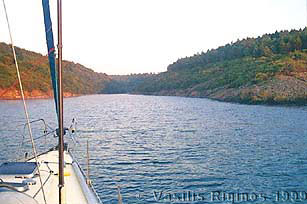
We departed Yakakent at 0700. There was no need to do anymore in preparation since the zodiac was already lashed on the deck, all we had to do was to raise the anchor. It was raining and the wind was very light but the waves were large. After we had motored for a few miles the wind increased to 8-10 knots NNW and the waves subsided. We motor-sailed for a while with both sails until the wind decreased again and we had to roll-in the headsail. I had to reactivate the watermaker by priming it and running it for half an hour to flush the biocide. After that it worked well and it started to replenish our water supply.
We arrived in our destination, the Hamsilos Cove [42° 03.6' N, 035° 02.6' E] at 1325. We had covered 33.9 M. Before entering the cove, as we were lowering the main sail the ring on the boom to which the topping-lift line is attached broke. We had quite a time trying to catch with the boat hook the line which, helped by the wind, was flying all over. Finally Andonis caught it and I made a temporary repair by attaching it at another place on the boom using a spare shackle.
Hamsilos is a real cove, one of the three in the whole S shore of the Black Sea. The water in the cove is somewhat clearer than at the other places we had been in the Black Sea, but still murky. The cove is surrounded by green hills with pine trees. By now the morning rain had given way to bright sunshine. The place, other than its water, would have been idyllic were it not for a road which brought cars with picnickers. Many took pictures of Thetis with their flashes flashing. It was not the picnickers that bothered us. The road had also brought dump-trucks which dumped refuse.
We launched the zodiac. While doing so we noticed that the plug of its self-bailing hole was missing. This plug was secured by a cord. The cord was broken. I did not have a spare. It was really perverse that no matter how many spare parts you carry it is always what you do not have that will be needed. The problem was not catastrophic but more of an inconvenience. Without the plug, some water would enter the zodiac when it was not under way, and we will have to bail it frequently.
We put up the tent. The zodiac was absolutely filthy having accumulated mud, weeds, and other dirt from the Samsun harbor. After a swim, I spent some time washing the zodiac thoroughly with detergent. I also scraped the weed and barnacles from the propeller. Andonis thought that I was excessive.
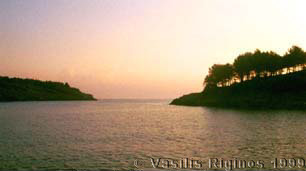
After our swim we had a long nap, as we were lacking sleep because of our midnight encounter last night. In the evening, we had our ouzo and I made spaghetti with an olive oil and garlic sauce. This we ate in the cockpit accompanied by a red Villa DeLuca wine. The wine was not very good. It was a little spoiled by air entering through its cork. Other than that, it was a most enjoyable evening. The sky was clear and full of stars. The barometer had risen to 1012 mB and the relative humidity was a comfortable 76%.
As we were ready to retire for the night we heard the sound of a nearby engine. Then a strong flood-light illuminated Thetis. We rushed outside and turned on our own floodlight. The thought that crossed both our minds was that here we go again, another nocturnal visit! It turned out to be a large fishing boat. It came straight at us. This time, however, it was not a problem. The fishing boat maneuvered skillfully along our side and the captain asked us in broken English if we had any trouble and needed help. I suppose it was difficult to understand that any sensible person would voluntarily choose to spend the night anchored in an isolated and dark cove rather then being near other people in a well-lit harbor. We assured him that we had no trouble and thanked him for his concern. They left, and we went to bed. Once again, we were touched by the kindness and hospitality of the Turkish people.
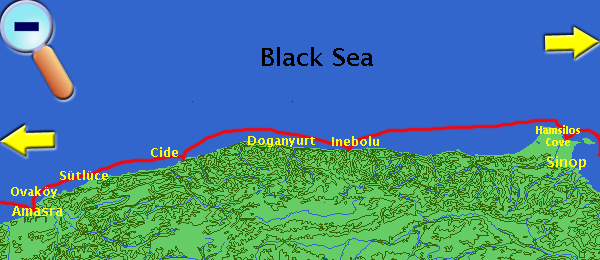
Saturday August 7, 1999, Day 26
We woke up early, at 5:00, so that we could have an early start. It was very misty, with puffs of mist rising from the water. A most dramatic and eerie morning. We raised the zodiac and pulled up the anchor. We departed Hamsilos at 0620. While motoring, I washed the bottom of the zodiac with detergent. We crossed paths with a cargo ship on an opposite course. We waived to each other. Crossings with other vessels are not that common in the Black Sea. The day was cloudless with bright sunshine, the first such day we have had since Thetis left the Aegean. The barometer, however had fallen to 1009 mB while the temperature was 23° C and the relative humidity was up to 81%. No wind.
After we rounded Ince Burun, the wind increased to 8-12 knots E and later to 10-18 ENE. This allowed us to raise the main and have a nice quiet downwind sail all the way to Abana. As the wind was almost 180° from our course, I strung a preventer line to avoid unintended jibes. As we were approaching Abana, our intended destination, the seas, which since Ince Burun had been calm, increased to 2-3 m waves. The Black Sea Cruising Guide indicates that the entrance to Abana harbor has depths of 3-4 m. They also say that in 1993 they had run aground inside the harbor. Because of this we proceeded with great care and apprehension. As we tried to enter, the depth appeared to me to be less than 2 m and I aborted. We decided to proceed to Inebolu about 10 M further.
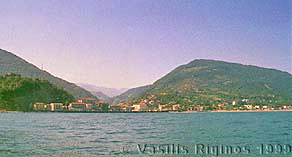
It was somewhere around here that Andonis (Professor Ephremides) proposed the Zofor scale as an improvement on the commonly used Beaufort force scale. The Beaufort force scale is a logarithmic scale that characterizes the velocity of the wind. That is force 1 corresponds to 1-3 knots, force 2 to 4-6 knots, all the way up to force 12 which corresponds to over 63 knots. A gale is defined at force 8 (34-40 knots) and a strong gale at 9 (41-47 knots). All of this, argued Andonis, is well and good but not enough. A strong breeze of force 6 is delightful when sailing downwind or in a broad reach but as a headwind it can be sheer torture. What we need is a wind equivalent to the wind-chill factor that describes comfort or lack there of. Hence the Zofor scale named after the Greek word zoferos (ζοφερός) meaning difficult, gloomy. The Zofor scale will not only take into account the wind velocity, but the direction of sail, the sea conditions, the amount of sunlight, etc. So a downwind sail at Beaufort force 6 in not too rough sea and sunshine will be a mere 4 on the Zofor scale while an upwind sail with the same conditions will be 8 on the Zofor scale. Warming up to the idea, since we are, after all, both electrical engineers, we started thinking of a Zofor instrument. This would be, of course, microprocessor controlled and would be integrated with all the other boat instruments, including the motor. So, if the motor is on, the Zofor force will increase since sailing is more pleasant than motoring.
Since we had already lowered the main sail, we just unrolled part of the genoa and motor-sailed to Inebolu [41° 58.8' N, 033° 46.1' E] where we arrived at 1725, having come 55.5 M from Hamsilos. Near the harbor entrance we encountered a group of dolphins. We entered this industrial harbor without any difficulties and we anchored off-shore. The anchor held firmly after our second attempt. Our first attempt had brought us too close to a floating buoy. We had anchored at 5 m depth and had to let-out over 40 m of chain because there was a very strong swell entering from the E into the harbor. The harbor was ugly, with several ships loading coal. Yet, its water was much cleaner than the water in Samsun. And most importantly there was no smell!
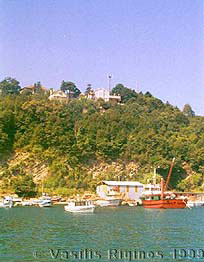
We launched the zodiac and went ashore to investigate if we could get any fuel. There was a gas station about a 5 minute walk from the harbor towards the town (which is W of the harbor). They were out of Diesel fuel but will have it by 9:00 tomorrow morning. We continued walking to the town. Again, despite its industrial nature, Inebolu was much more attractive than any of the towns we had seen between Samsun and Trabzon. It has a fairly nice and more-or-less clean beach and older buildings. I took 50 million TL from an ATM and we bought some bottled water. We found a promising looking restaurant in an old building near the shore. It was on the second floor and rather old fashioned with a nice view of the sea. We had a nice assortment of appetizers which were followed by tasty kebabs. It would have been a perfect meal had it not been interrupted by a roaring sound. A truck was spraying the streets with a heavy cloud of insecticide. Andonis’ reaction was not as strong as Scott’s when a similar spraying took place in Eskifoça.
Back on Thetis the wind had shifted to 5-8 knots SW and as a result the swell was substantially less. We had a good night’s sleep.
Sunday August 8, 1999, Day 27
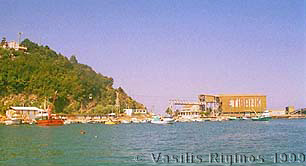
I checked the e-mail, I had messages from both Alice and Corinna. The e-mail now seemed to be working fairly well. All the problems we had on our way-in were gone, it must be that something had been changed in Greece. Before going ashore, we transferred two 25 L jerry cans of fuel into the main tank and then took the empty cans ashore. We put them on the hand cart and carted them to the Ofisi gas station. A young boy promptly filled them with 47 L of fuel. Andonis went to pay using his credit card. The man in the office, different from the man we spoke with last night, not only accepted the credit card but offered to drive us with the cans to the harbor. We gladly accepted this nice offer.
After leaving the full jerry cans in the zodiac, we walked to the town where we bought some terrific sourdough bread from a wood-fired bakery, some fruits, and 4 more bottles of spring water. Then we went back on board Thetis and prepared to leave. We raised the zodiac and started pulling up the anchor. An incredible amount of mud and some gray foul-smelling stuff was lodged on the chain and anchor. While I was slowly raising the anchor, Andonis was drawing bucketfuls of water and washing the chain.
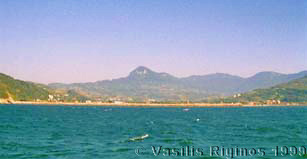
We left the harbor of Inebolu at 1055, heading to Cide. At the beginning there was hardly any wind but a respectable swell. We put up the tent and motored. Later the wind came from the NNEE at 8-12 knots and we motor-sailed with the genoa. By the afternoon the wind had increased some more to 15-25 knots and we were able to sail. We sailed downwind most of the way to Cide. The waves were large, 3-4 m, on our stern. We saw a large school of dolphins but they did not approach us too closely.
We arrived in Cide [41° 54.1' N 32° 58.8' E], still sailing, at 1650. After we rolled in the headsail, we entered the harbor and anchored off-shore. The holding was good. We had come 33 M from Inebolu. Docked side-to was the French ketch we had seen at Kalamis and at Sile two weeks ago. This is the first sailboat we have met, other than a glimpse of one on an opposite tack just outside Sile, all this period. We took our time going ashore, launching the zodiac, taking showers, etc. We had some ouzo, listened to Tsitsanis on a CD, and in general we were being kind of lazy. From where we were, in the boat, the place looked rather attractive.
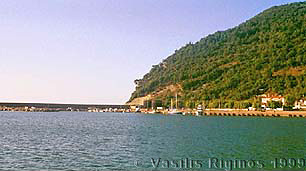
Finally, we got into the zodiac and went to meet the crew of the French ketch. Andonis spoke to them in French, since their English was limited. They were a couple and a young boy. The boat had come all the way from Brittany but she changed skipper and crew in Istanbul. It took them 3 whole days to iron out the bureaucracy, so it seems that we had escaped relatively lightly. Cide was as far as they had penetrated into the Black Sea. They, however, had been taking day-trips with buses into the interior. They were going to eat aboard and were not interested in joining us at a restaurant. We walked around. The town is at some distance inland. It is spread out and it is not very appealing or interesting. The town does not appear to be a definite center. It has almost no stores but it does have at least 3 law offices! We did, however, find a good bakery with a warm and very good corn-bread. The only restaurants we saw were near the shore and were all large but none of them had any customers and the food offerings were meager and not too tempting.
We retired back on Thetis and Andonis made a large salad which we ate with the corn-bread and washed it down with a chilled Greek wine. I felt sort of tired and went to bed at 10:30. I instantly fell asleep.
Monday August 9, 1999, Day 28
The barometer rose overnight from 1005 to 1007 mB. We were still riding a barometric high. The relative humidity in the morning was 77% and the temperature 19° C (66°F). We started raising the anchor and had the same problem of mud in the chain as we had in Inebolu, which necessitated buckets, etc. We left Cide at 0800.
Outside the harbor the waves were small and there was hardly any wind. We motored along the coast, which provided us with very dramatic scenery. Tall mountains, very steep, and very green. The water here was less blue in color than it was further east, it was a greenish color. We put up the tent. It was calm enough to allow us to turn on the watermaker. The intake of the watermaker is not a the lowest point under the hull, and as a result, when Thetis is heeling or the sea is rough, air enters and de-primes the watermaker pump.
We arrived, still motoring, in Amasra [41° 44.9' N 32° 24' E] at 1250, 28.1 M. We anchored off-shore without our previous problems at exactly the same spot we had anchored on our way in. I tried to call Çoban but there was no answer. We sent e-mail to Alice and to Jane in Washington. The beach was full of people having fun in the sea. There were a number of sailing dinghies and at least one windsurf. There was a definite air of holiday. The water was full of large, very large, jelly fish. It was nowhere as attractive as the clear Aegean water. After a swim and a snack we both had a siesta under the tent.
Docked among the fishing boats there was a sailing yacht with a Turkish flag. When we went ashore, we walked over and looked for her captain but there was no one aboard. We did some shopping of fruits, vegetables, bread, and bottled water. We also looked, but in vain, for a cap to replace the lost bailing cap for the zodiac. We took our shopping back to Thetis. We then removed the tent and had hot showers and an ouzo. When we went ashore again, we saw Çoban briefly at the “Yacht Club.” We then walked to the Çesme Cishavik restaurant, where we ate last time. Our waiter friend “Elvis Presley” was still there ready to serve us. We had a large salad and palamud (bonito) but it was nowhere as good as last time. It felt very greasy.
After eating, we walked once again to the Turkish yacht. She is named Younous, which means dolphin, but she is not the Younous I had met last year at Lipsi. She was crewed by a middle aged Turkish couple and they had been participating in the round the Black Sea Kayra Rally. They had left the rally in Odessa and sailed to Amasra to be in place for the solar eclipse on August 11. The man had retired from practicing medicine, purchased a boat, and learned how to sail, just two years ago. Before participating in the Black Sea rally, they had been part of the Aegean rally earlier this year. They invited us for a drink but we were too tired and went back to Thetis to sleep.
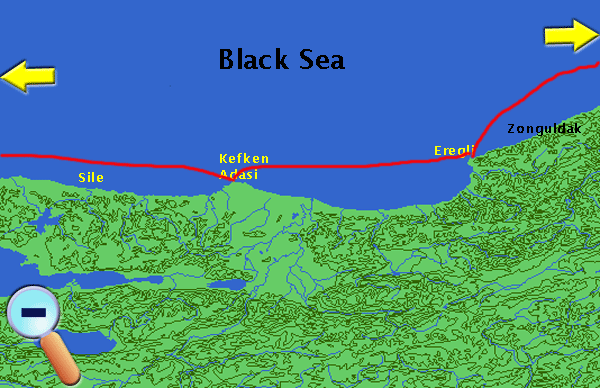
Tuesday August 10, 1999, Day 29
I had a bad night. Something that I ate did not agree with my stomach, probably the greasy tuna fish, or the oil in the salad which was not the olive oil that I am used to. At any rate, I was up sick since before 5:00 AM. Since I was up, I started preparing the boat so that we could leave as soon as Andonis was up.
We departed Amasra at 0610, heading for Eregli. Our departure presented no problems other than that I felt lousy. There was a slight SE wind and we motor-sailed with the headsail and the tent. Later even this wind died out but there was some swell, although it was not too bad. When we were near Zonguldak, a Turkish patrol boat appeared on the horizon and headed straight at us. There was not very much we could do other than tune our VHF to channel 16 and listen. As they were approaching us a small airplane flew over us very low and circled. We never figured out if it was related to the patrol boat or not. When the patrol boat was right next to us we heard on the VHF a flood of Turkish. I responded in English by saying; “Patrol boat, patrol boat near Zonguldak, this is the sailing yacht Thetis, Thetis, right next to you, over.” There was no response. They overpassed us, then slowed down and turned back. One man on deck was waving signal flags, while another was manning the machine gun. This was not a very comfortable situation. I have to admit that I do not know how to read signal flags and it would have taken us way too long to find a book to decode them. Instead, I waved at them our portable VHF. This seemed to work. We heard the following hail: “Sunshine, Sunshine.” This was definitely directed at us because Sunshine is the model of Thetis and is written on both of her sides. I replied promptly: “Patrol boat, this is Sunshine, our name is Thetis, Thetis.” They then asked us to switch to channel 72. We did so and waited. They called:
— Please repeat name.
— Thetis, I spell Tango, Hotel, Echo, Tango, India, Sierra. Thetis, over.
— Thetis, is this correct?
— Affirmative, over.
— Thetis, what country are you registered?
— Greece, Greece, Yunanistan, over.
— Where are you going?
— Eregli today, then Istanbul, over.
— How many persons are on board?
— Two, Two, over.
— Thetis, this is the Coast Guard, have a nice trip, out.
— Coast Guard, this is Thetis, thank you, you too have a nice trip, out.
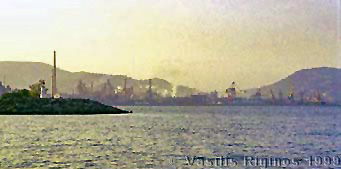
It was over and they sped away. A lone dolphin came and played with our wake for a long time. I definitely felt sick. There was not much wind and it was fairly calm.
We arrived in Eregli [41° 16.5' N 31° 24.5' E] at 1545 having covered 56.1 M. As luck would have it, just before entering the harbor the wind had picked up to 25 knots E with stronger gusts of about 35 knots.
Eregli the ancient Greek Herakleia (Ηράκλεια) was founded in the 6th century BC by Greeks from Megara and Tanagra. It became one of the most important commercial and cultural centers in the Hellenic Black Sea. It was believed to have been near one of the entrances to Hades, the very entrance that Hercules used to enter the Hades in his labor of fetching the three headed dog Cerberos. Xenophon in 355 BC, on his way back to Greece, stopped at Herakleia and was shown the place on the Acherusian peninsula where Hercules entered Hades. In 364-353 BC Herakleia was ruled by the tyrant Clerachos who was credited with liberating the serfs and building the first public library. His dynasty stayed in power until 288 BC. His son Dionysios ruled over several cities including Sesamos and Tieum. He was married to Amastris the founder of Amastris (Amasra). In Roman times, Herakleia was an ally of Mithridates Eupator (c 120-63 BC) and as a result was razed to the ground by the Roman general Cotta. Strabo describes it as a city with a good harbor. The Byzantines built a citadel here. In 1360 AD the town was taken by the Ottomans but was also used by the Genoese as a trading post. It was later incorporated into the Ottoman empire. In 1922 its sizable Greek population was forced to abandon their homes, under the Greek-Turkish treaty.
There were many famous people from Herakleia including Heracleides Ponticos (c 390-310 BC) who was a student of Plato and proposed the Heliocentric system, and Dionysios of Herakleia (c 330-250 BC) who was a stoic philosopher and friend of Zenon, the founder of stoicism.
The historical information on Eregli as well as on other Black Sea locations comes from Turkey, Blue Guide and from Mariana Koromila's Πόντος - Ανατολία: Φωτογραφικό οδοιπορικό - Pontos - Anatolia, Fotographico odiporiko (in Greek).
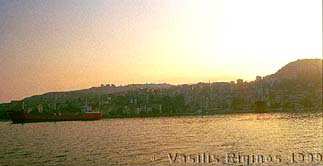
Now entering the harbor of Eregli, with its large steel mills, the largest in the Middle East, appears as the entrance to a modern version of hell. It is a very large harbor, busy with many large ships, some docked some moored off-shore. The wind by now was blowing hard. Despite the amount of shipping the harbor was actually not as dirty as Samsun. Nor did the town look as bad as our first impression. The mills are all at the western end and the town seems to have a large promenade shaded with trees at its eastern end. The town has some green parks, and is built amphitheatrically. We anchored off-shore between two rusted ships.
In the outskirts of Eregli there is a cave, the cave of Hercules which is believed to be the entrance to Hades. I have been dying to visit this cave but by the time we made sure that the anchoring was secure I felt so bad that my only desire was to crawl into my bed. I helped Andonis launch the zodiac and watched him as he went ashore to find a restaurant highly recommended by the Black Sea Cruising Guide. I just made some plain rice and forced myself to eat it. As I was about to go to bed, Andonis came back. He did not succeed in finding the restaurant, so he fed himself with whatever we had in the fridge.
Wednesday August 11, 1999, Day 30
Today was the day of the solar eclipse. We were very exited because we were very close to the area of totality. I felt better than yesterday but not yet completely recovered. Overnight we received two Navtex warning messages: one was about a firing practice west of Sile on August 13 and the other that Bosphorus will be closed to all traffic tomorrow and on the 14. The implication of these messages was that we must cover the leg from Kefken to Poyraz tomorrow to avoid the firing area, and then transit the Bosphorus on Friday the 13 while it is open and before the 14th. We were with other words between the Sympligades Rocks of the Argonauts.
We transferred fuel from the two 20 L cans to the main tank and we departed Eregli at 0700 heading for Kefken Adasi. The sea was fairly calm and there was not enough wind to sail. We motored. At about 1000 a new Navtex signal arrived, now they have changed the firing to east of Sile and have advanced it to tomorrow morning. We revised our plans once more. If we stay at Kefken Adasi till 2230 and then sail overnight we will be way clear of the firing area by 0800 tomorrow when they start firing. We can then stop at Poyraz and wait for the Bosphorus to open the next day.
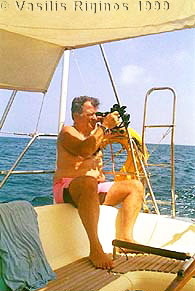
By 1300 we started seeing the beginning of the Solar eclipse (more info on the eclipse can be found at the ESA eclipse site). Earlier in the summer, while in Samos, I had asked Andonis to find and bring some suitable filters that would allow us to view the sun during the eclipse. In his frantic days before his departure he forgot all about them. I was a little annoyed at him and was planning to make a pin-hole camera-obscura and project the image of the sun. How stupid of me. It had completely escaped me that I already had a much better instrument aboard Thetis for these observations: the sextant. It not only has all the needed filters but a small telescope for clearer view. So now, armed with the sextant and while the boat was gliding in the smooth sea and we were comfortably sitting under the tent, we started looking at the sun through the sextant and its filters. It was a fantastically clear view. At first only a tiny part of the sun was missing. As time progressed towards 1417, the exact time of the totality in our position, more and more of the sun was covered by the moon. Andonis and I took turns observing it. At 1417 the sun was completely covered, only a tiny ring of light, the corona, was visible. We were not in the dark but we were surrounded by an eerie light similar to dusk or as if a heavy cloud was obscuring the sun, yet there was no cloud. The sky darkened and Jupiter and Venus were briefly visible. The effect was brief, it only lasted a few seconds. Then a sliver of the sun reappeared and it started growing. It was very exiting.

Entering the Eclipse |
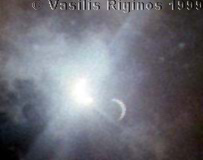
Further into of the Eclipse |
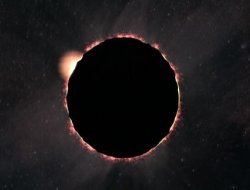
Photograph of totality |
|
We arrived at Kefken Adasi [41° 12.7' N, 030° 15.5' E] at 1530 having covered 52.4 M. A gulet was already there. This was the first gulet we had seen since leaving Istanbul. We speculated that it must have come for the eclipse. The cove was fairly peaceful. The island is low lying and marred by a fish farm and a concrete quay. The mainland just across is green and attractive. The water however was full of jelly fish.
Despite the jelly fish I swam a little and then rested. We were buzzed by 4 jets which flew with ear splitting noise just above our mast. By the evening, and after a hot shower I began to feel much better again. Andonis would not have any other dinner cooked but plain pasta with a sauce of olive oil and garlic. I cooked this and we ate it in the cockpit along with a chilled white wine I had from last years’ visit to Limnos. The night was clear with no moon. We passed the time in the cockpit listening to music on the CD player.
We departed Kefken Adasi heading for the Bosphorus at 2240, as scheduled. There was hardly any wind but some swell. As soon as we were cleared of land, we started a 2-hour watch system. I took the first watch. Andonis by now has not only become a competent night sailor but he was actually enjoying these night passages.
Thursday August 12, 1999, Day 31
A ship appeared 8 M away but she was not on a collision course with us. Later the wind picked up a little from the S so I opened the headsail and we motored-sailed but the wind did not last very long. The sky was clear and full of stars. I woke up Andonis with his favorite opera, Bellini’s Norma with Maria Callas and Franco Corelli. During Andonis’ watch we received a Navtex message canceling yesterday’s about the Bosphorus being closed to traffic today. It will be closed tomorrow instead. Change of plans again. We have to transit the Bosphorus today.
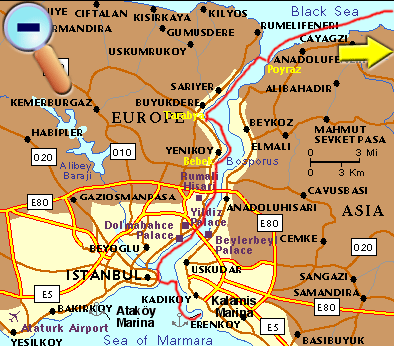

By daybreak we were west of Sile and had cleared the area where the firing practice was scheduled for 0800. So, all dangers were behind us now. As we got closer to the Bosphorus a very heavy fog rolled-in from ashore. It was strange because it was very patchy as it flowed from the land to the sea, looking like a river. There were perfectly clear patches and extremely dense patches. We slowed down in the hope that it would dissipate before we reached the straits. I tried hailing the Bosphorus Control on the VHF, using the channels written on the chart (11, 12, and 13) but they did not respond. Nevertheless we kept monitoring these channels. We proceeded very slowly and with some trepidation, carefully watching the radar. We heard on the VHF that the Bosphorus Straits were now closed to all traffic because of the fog. There was a lot of radio traffic between Bosphorus Control and many large ships waiting to transit. When we were near the entrance of the Straits, the fog was somewhat less dense and we could see both banks. Since Poyraz was less than a mile from the entrance we kept going, very, very slowly.
We arrived at Poyraz [41° 12.2' N 29° 07.7' E] at 0810, after 50.8 M. We could not proceed further into the Bosphorus because it was still closed, so we anchored. While discussing various plans and contingencies for the rest of the day, I felt completely overwhelmed with fatigue. I was under the impression that Andonis was also very tired, but maybe I was just projecting my own feelings. I excused myself and retired to my cabin where I fell asleep for over an hour. When I woke up Andonis too was sound asleep. I listened to the VHF just in time to hear the announcement that normal operations were being resumed and the Straits were now open to traffic. I decided that the best strategy was to go now before the traffic got very thick and stop if possible at Bebek, which is about ⅔ of the way to Istanbul and beyond the point of the cable operations. If we found it a pleasant and secure anchorage, we could spend the night there and go to Kalamis tomorrow. If not, we would still have plenty of time to reach Kalamis during daylight.

We raised the anchor and left Poyraz at 0945. We crossed the Straits at 90° to the European bank and started our transit, this time pushed by the current. While I kept the engine RPM low and our speed over water under 4.5 knots, our actual speed over the ground was an amazing 8 knots. We were overtaken by a monster tanker, fully loaded, flying the flag of Luxembourg. She kept passing us, and passing us. Her bow wave was a frightful sight, much larger then Thetis. Her beam was incredible. This is by far the largest vessel that I have ever seen. Fortunately the fog was totally gone by now, but there was some wind from the S.
We entered the cove of Tarabya, where there is a seafood restaurant that my brother Nikos had recommended very highly. There was definitely no room for us to anchor. We proceeded to Bebek, past the first suspension bridge. It was also crowded. The information on Bebek from Heikell is very inadequate. We approached some caïques and a man indicated a spot for us, talking in Greek. I am sure he wanted to be helpful but we almost ran into trouble by following his advice. The depth went very quickly from 4 m to less then 2 and the depth alarm started sounding just as we touched the bottom. It was dicey because the wind was pushing us toward shallower water. Some furious revving of the motor, in reverse, extricated us. We were lucky! Most other free areas were over 18 m deep. We tried anchoring a few times but with this depth, the wind, and the current, it was hopeless. I tried once more on the S side of the cove. The anchor did hold at 14 m but it was not a comfortable place because we were completely exposed to the wake of the passing ships. We gave up on the idea of staying at Bebek.
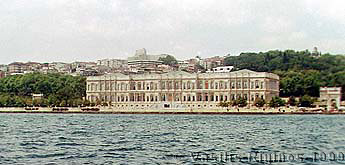
We continued on our way to the Kalamis Marina in Istanbul. Although we did have a reservation for tomorrow, I called them with the GSM phone just to make sure that we could have a berth today. The young receptionist who spoke good English answered the phone. She remembered us well (not too many Greek boats visit the marina) and assured me that there would be no problem with a berth and that they would be expecting us.
We arrived at Kalamis [40° 58.6' N 29° 02.2' E] at 1450, our distance from Poyraz was 17.7 M. Instead of going directly to our berth we first docked side-to at the fuel dock. We filled our tank and the two 20 L jerry cans. All together we got 101 L of Diesel fuel. Then we docked at the berth that we were assigned. It was hot. We were both very tired and irritable. Still we had a lot of tasks to do before we could relax. The docking lines had to be replaced with more permanent ones with shock absorbers, the zodiac had to be launched to allow us to open the central hatch and let air into the main cabin, the temporary lines had to be stowed, etc.
Finally, all was done and we could take much-desired hot showers. We then walked to the marina office and filled their forms. At last we sat down at the snack bar, had a bite to eat and a cold beer. Now we both began to feel human again. Fortified, we borrowed one of the marinas carts and bought 24 bottles of spring water from a new supermarket that had just opened.
In the evening we ate at the marina restaurant and then, hot and tired as we were, we retired early.
The total distance we traveled from Samsun to Istanbul was 383 M and 73 travel hours.